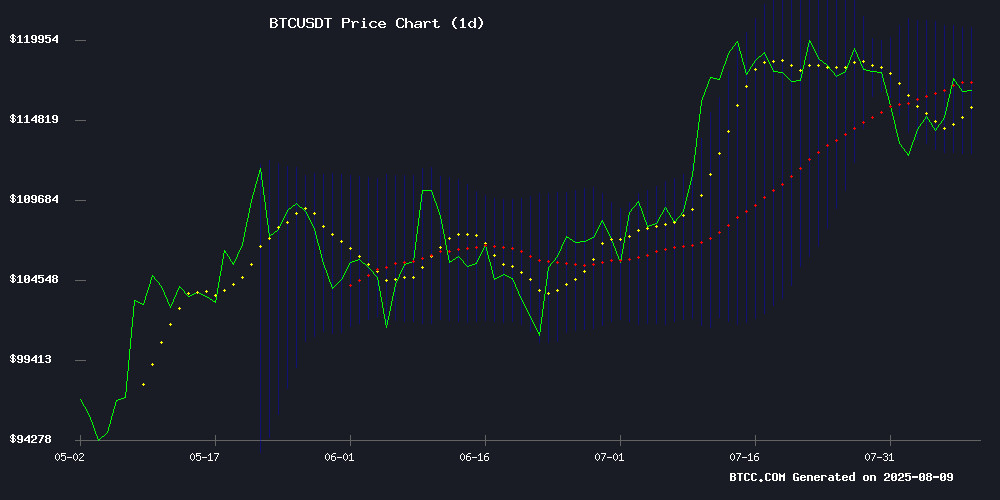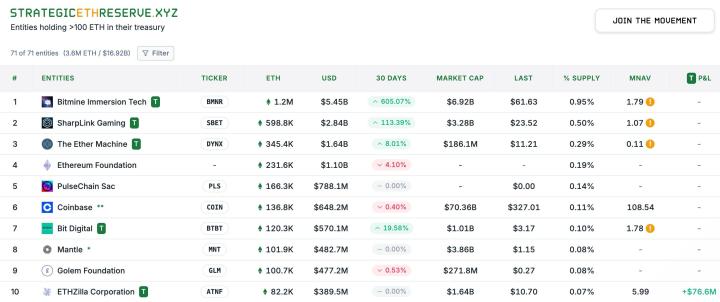- Technical Aspect: Short-term consolidation needs and long-term bullish structure coexist, with key support at 112,669 USDT
- Fundamental Aspect: Mining recovery and institutional position growth form price bottom support
- Regulatory Aspect: Global compliance process will determine the timing of large-scale capital inflow
BTC Price Prediction
BTC Technical Analysis: Short-term Pullback but Long-term Structure Remains Strong
According to BTCC financial analyst Emma's technical analysis, the current BTC price (116,580 USDT) is slightly below the 20-day moving average (116,697 USDT), indicating a potential short-term consolidation. The MACD indicator shows bullish momentum still dominates (histogram 761.23), while the Bollinger Bands width is converging, with price fluctuating near the middle band, suggesting the market is accumulating energy.
Emma noted: 'Although there might be a test of the Bollinger lower band support at 112,669 USDT in the short term, the MACD golden cross structure is complete, and after a pullback, it is expected to challenge the upper band (120,726 USDT). The key is whether it can stabilize above the 20-day moving average.'

Market Sentiment and Regulatory Dynamics: Dual Driving Forces in Crypto
BTCC analyst Emma interprets recent news: 'Ukraine will review crypto legislation, and the massive BTC transfer by Bhutan has triggered market anxiety, which may intensify short-term volatility. However, continued institutional positioning (Brown University increased ETF holdings to $13 million) and mining recovery (network hash rate near historical high) indicate medium to long-term confidence.'
Notably, US wealth platforms are restricting BTC ETF access, which contradicts the 'greedy' market sentiment. Emma believes: 'This reflects the adaptation period between traditional finance and crypto ecology, but the potential access space of the $31 trillion market remains a long-term catalyst.'
Factors Affecting BTC Price
Ukraine to Review Cryptocurrency Regulatory Law by August 2025
Ukraine plans to review its cryptocurrency market regulatory law by August 2025, marking an important step in its digital asset framework. The legislative proposal includes a 5% personal income tax and 5% military tax on crypto transactions, along with provisions for legalizing acquired digital assets. Notably, the law also proposes incorporating Bitcoin into national reserve assets.
Ukraine currently holds 46,351 Bitcoins, valued at approximately $5.4 billion, making it the fourth-largest government Bitcoin holder globally. This builds on the 2022 legalization of cryptocurrency exchanges, further solidifying the country's commitment to a structured digital economy.
Crypto Market Sentiment Remains Greedy Despite Fear and Greed Index Decline
The crypto Fear and Greed Index has fallen to 67, though still classified as 'greedy' despite the recent decline. Market participants continue to show risk appetite, though the indicator has moderated from recent highs.
This composite index, weighted by volatility (25%), trading volume (25%), social media activity (15%), survey questionnaires (15%), Bitcoin dominance (10%), and Google search trends (10%), indicates persistent bullish sentiment. Bitcoin's market leadership remains a key factor in the calculation.
Bhutan's Transfer of $59 Million in Bitcoin Sparks Market Anxiety, Derivatives Market Warns of Leveraged Long Liquidation
The Bitcoin derivatives market is flashing warning signals, with funding rates plummeting below 0.01%, reflecting rapid liquidation of leveraged long positions. Amid rising market tension, reports suggest Bhutan might sell part of its $1.2 billion Bitcoin holdings—the country recently transferred $59 million in BTC to an address associated with Binance.
According to Glassnode data, perpetual contract funding rates have significantly dropped from previous heated levels, indicating traders are reducing speculative positions. While this cooling reduces long squeeze risks, it also suggests cautious sentiment is spreading after weeks of aggressive bullish leverage.
The potential selling pressure from this Himalayan kingdom adds another variable to an already fragile market, sparking a new round of debate about the impact of sovereign crypto holdings on price stability. Binance's potential involvement as a liquidity channel further focuses attention on exchange fund flows during volatility.
Block CFO Foresees Bitcoin Evolving as Internet's Open Protocol, Announces Next-Generation Mining Chips
Block CFO Amrita Ahuja envisions Bitcoin transcending the 'digital gold' narrative to become a foundational protocol for internet-based value transfer. In a CNBC interview, she emphasized Bitcoin's unique ability to transfer funds at network speed, positioning it as a potential global transaction backbone.
The fintech company continues to invest in Bitcoin infrastructure, planning to launch next-generation mining chips in the second half of 2024. These developments aim to enable more people to participate in Bitcoin's security model while supporting the network's transition to mainstream payment tools. Currently, thousands of Square merchants accept BTC, indicating growing commercial adoption.
Bitcoin's Decade-Long Journey: Patience as the Ultimate Investment Strategy
Time is the fairest asset—universally distributed but often appreciated only after loss. Bitcoin's 16-year development trajectory is fully revealed through its decade-long price trend chart. Investors who bought BTC ten years ago can now enjoy a 300-fold return, but few possess the discipline to navigate through volatility.
The market doesn't care about individual intelligence; it's a product of collective emotion. Success requires resisting impulsiveness and leveraging time's compounding effect. Opportunities are everywhere, but only those who master patience and emotional control can truly profit.
US Wealth Management Platform Restricts Bitcoin ETF Access Despite $31 Trillion Market Size
White House Cryptocurrency and AI Head David Sacks points out a clear disconnect in the US wealth management field. Due to restrictive policies of major banks, approximately $31 trillion in assets remain unable to invest in BTC ETF.
Top institutions continue to block or limit cryptocurrency ETF exposure on their platforms, and Sacks believes this may reflect a lingering "de-banking" bias. Despite growing institutional demand and regulatory approval of these investment tools, obstacles persist.
Brown University Increases BTC ETF Holdings to $13 Million
Brown University has significantly expanded its cryptocurrency investment portfolio, currently holding $13 million in BTC ETF shares. This Ivy League institution increased exposure through BlackRock's spot BTC ETF, demonstrating growing institutional confidence in digital assets.
This move aligns with the overall trend of top university endowment funds cautiously embracing cryptocurrency. While many universities remain hesitant, Brown University's expanded holdings indicate that institutional investors are beginning to view BTC as a legitimate store of value.
Bitcoin Mining Strongly Rebounds: July Production Rises, Network Hashrate Approaches Historical Peak
The BTC mining industry demonstrates remarkable resilience, with major players like Marathon Digital (MARA), Cipher Mining, and Cango showing significant production growth in July. After a challenging June, the industry's recovery is evident, showcasing its ability to adjust infrastructure and optimize energy strategies amid market volatility.
Blockchain.com data shows network hashrate has surged near historical peaks, signaling a new expansion momentum. This recovery occurs against a backdrop of mining difficulty rising to 127.6 trillion (August 2025 record), with miner revenue paradoxically growing 105% year-on-year, breaking traditional difficulty-revenue correlation expectations.
Cipher Mining mined 214 BTC in July, increasing inventory to 1,219 BTC. The company's Q2 2025 financial report indicates revenue of $44 million, adjusted earnings of $30 million, driven by Black Pearl data center activation (hashrate expanded to 20.4 EH/s). CleanSpark performed even better, mining 671 BTC that month, with reserves exceeding 12,700 BTC and power capacity surpassing 1 GW.
How Will BTC Trend Develop in the Next 10 Years?
BTCC analyst Emma proposes a ten-year cycle framework:
| Phase | Characteristics | Price Driving Factors |
|---|---|---|
| 2025-2028 | Institutional Maturity | ETF Capital Inflow, Mining Carbon Neutrality Progress |
| 2029-2032 | Protocol Layer Expansion | BTC Adoption Rate as Internet Settlement Layer |
| 2033-2035 | Global Reserve Asset | Sovereign Wealth Fund Allocation and Cross-Border Settlement Applications |
"Technical indicators show a healthy correction currently," Emma emphasizes, "but next-generation mining chips and improved national regulatory frameworks will transform BTC from a risk asset to an open protocol within a decade, with volatility gradually decreasing."






